Fireplace Building Science – Pros and Cons
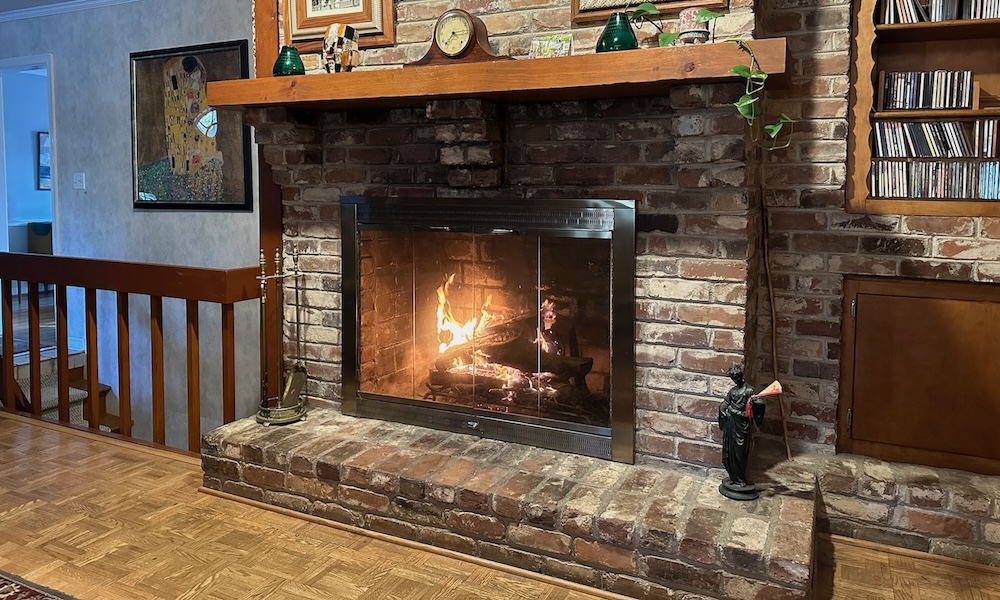
Ah, who can resist the ambiance of a crackling fire! Well, it turns out quite a few can. Whether to use a fireplace or not is a controversial topic in building science. The main problem is that a typical wood-burning fireplace actually has a net cooling effect on a home. (And that applies also to when they’re not in use if the damper stays open.) Then there’s the effect they have on indoor air quality.
So is having a fireplace worth it? I just used my fireplace (photo above) for the first time, so I’ve been thinking about it a lot lately. I’ve also had a lively discussion on LinkedIn about this topic, but let’s expand it here now.
Why have an indoor fire?
There are two main reasons people have fires indoors. One is to get the ambiance of that crackling fire. And the other is to heat the home. I’m going to focus on heating in this article, but keep reading even if you’re just an ambiance burner. I’ll discuss some issues below that might help you get the ambiance you want without the negative consequences.
Now, let’s discuss using a fireplace to heat your home. For some people, it’s the primary source of heat. For most, it’s supplemental. I’m in the latter category, or at least I will be when I’m done. The reason is that I want another source of heat to supplement my undersized heat pumps when it’s really cold or to provide emergency heat when the power goes out.
I have two Mitsubishi heat pumps heating my house, and neither of them has a backup heating system (called auxiliary heat when installed in the heating system). When an arctic blast came through Atlanta in December 2022, our heat pumps couldn’t quite keep up. Our indoor temperature went as low as 63 °F (17 °C).
Indoor temperature
Now, the Montanans, Vermonters, and Canadians are saying, hey, what’s the problem with that temperature? But not everyone wants such a low temperature in their homes. In fact, the Air Conditioning Contractors of America (ACCA) specify 70 °F (21 °C) as the indoor design temperature, and that feels pretty good to me.
But of course, there’s another aspect of fireplace building science I should mention here. My friend Robert Bean is always quick to point out that thermal comfort is about more than air temperature. When you’re in a building with a really good building enclosure—one that’s airtight, well insulated, and has good windows—you can be comfortable with air temperatures well below the recommended design temperature.
I know it’s true because I built a house with a good enclosure and was able to keep the thermostat at about 64 °F (18 °C) and be perfectly comfortable. It’s all about the mean radiant temperature.
Where does the air come from?
Now, back to fireplaces. When you start a fire, the combustion process pulls oxygen from the air. The bigger the fire, the more air it takes. And then the exhaust gases go up the chimney and leave the house. But one of the primary rules of air leakage is that when a cubic foot of air leaves the house, another cubic foot has to come in. Fireplace, meet some basic building science here.
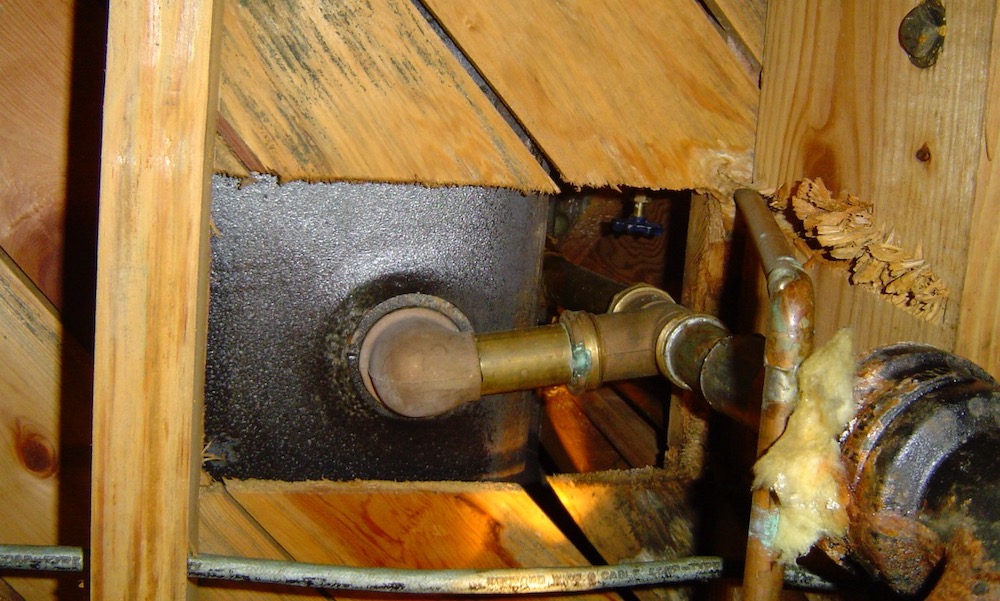
For the typical fireplace, that makeup air comes in through random leaks in the building enclosure. The photo above shows a big hole where the bathtub drain goes through the floor. As long as the fire is going, it’s pulling in air through these random leaks.
And here’s the thing: The air going up the chimney can include a lot more than just the combustion gases. As the chimney warms up, it creates a draft that can pull in even more air from the house due to the stack effect. The result often is a net loss of heat from the house. I think that’s what happened at my house when I made the fire this past weekend. And that was even with the glass doors closed.
Combustion in airtight homes
In an airtight home, it may be difficult to get a fire started or keep it going. If you want a fireplace in that type of house, you should looking at doing one or both of these two things: Provide combustion air in the fireplace or use a more efficient way of burning wood or both. But especially the more efficient way of burning wood.
Ducting air near the fireplace may or may not help much. You can draw all the arrows you want showing air coming in those ducts, but air follows the pathways of least resistance. Instead, by putting the combustion air directly into the fireplace, the fire will use less heated air from the home.
Even then, though, much of the heat from the fire may still escape up or out the sides of the chimney. And that’s why you want to burn the wood as efficiently as you can. Let’s start with the chimney.
Where is the chimney?
Chimneys come in many designs, but there are really only two types that matter for efficiency. Some chimneys are outside the house (photo below). When it’s cold outdoors, all that mass in the chimney is cold. That means is takes longer to heat up when you start a fire. It also means the chimney loses heat directly to the outdoors once it does heat up.
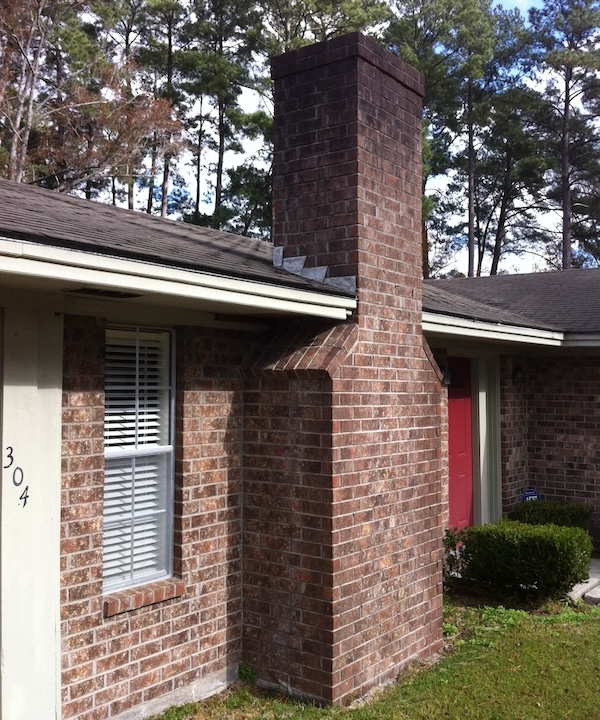
The more efficient style is the chimney that goes up through the house, as seen in the photo below. Except for the part that’s outside the building enclosure, the mass of the chimney is at about the same temperature as the indoors. In my case, the attic is conditioned so it’s only the part of the chimney above the roof that’s really cold.
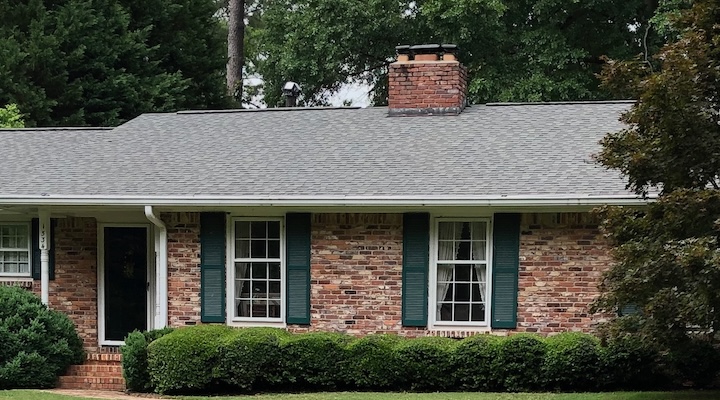
Outdoor temperature
The outdoor temperature matters for a couple reasons. First, the colder it is outdoors, the colder the makeup air for combustion will be. If that makeup air is going into the living space, it can create comfort problems. It also makes it harder for the fireplace to heat the house.
Second, if the chimney is on the outside, it’ll take longer to heat up and draft properly. That could put more pollutants in your indoor air.
Fireplace vs. woodstove
I had a woodstove in the house I built, and I loved it. It was a Vermont Castings model with a catalytic converter, and it could heat the whole house without much difficulty. That’s it in the photo below. It didn’t have combustion air ducted into it, and that wasn’t a problem even in my airtight house.
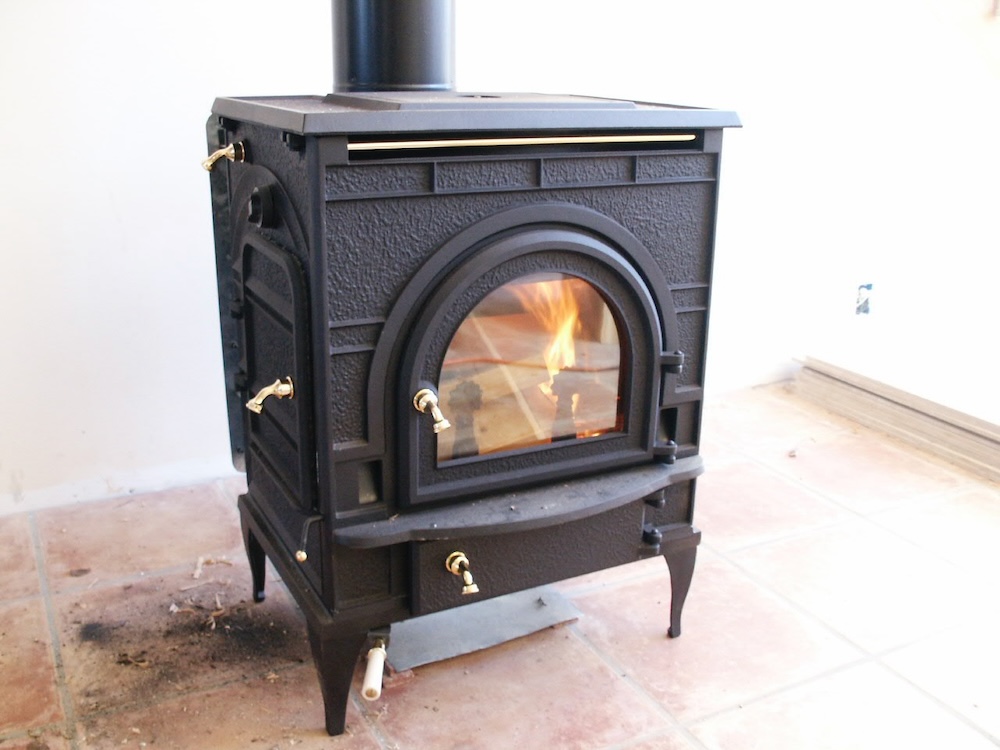
When I’d start a fire, I’d have to crack open a window but only until the woodstove got up to temperature. Once I switched to the catalytic converter, it used only a tiny amount of combustion air and I could close the window. I’ve read that efficient woodstoves might draw only about 15 cubic feet per minute (cfm), which isn’t a problem even in most airtight homes.
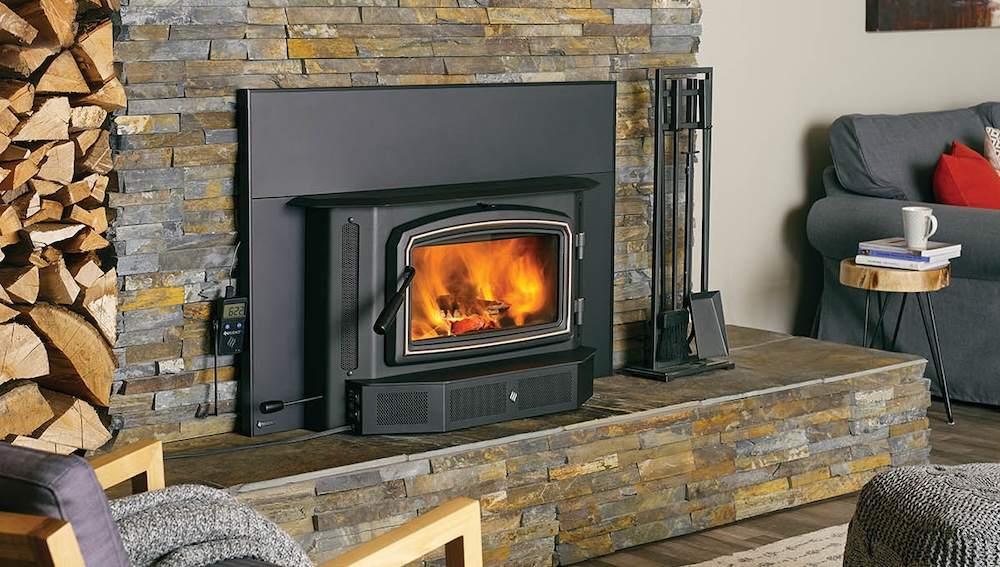
In my LinkedIn discussion on this topic, a lot of people gave recommendations for woodstove inserts, so check that out if you’re looking to do this.
Gas log fireplace
This article is about wood-burning fireplaces and woodstoves, but let me mention gas here briefly. They definitely beat wood-burning fireplaces in the convenience category since all you have to do is turn them on. The things I discussed above apply to gas fireplaces as well.
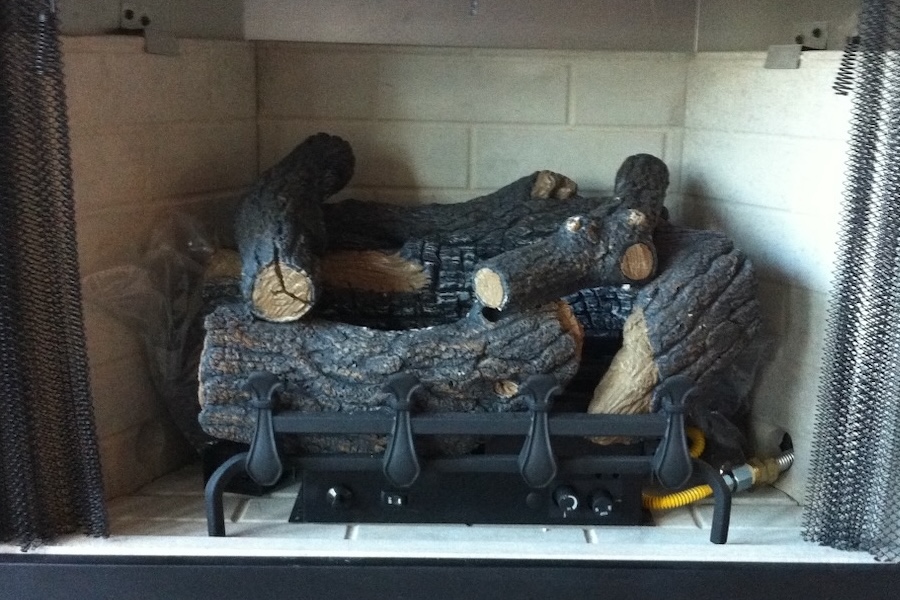
But one big difference is that, incredibly, it’s still legal in many places to use an unvented gas log fireplace. That means ALL of the combustion products go into the living space. Yeah, all the heat stays indoors, too, but that’s not as good as you might think. They also dump lots of water vapor, oxides of nitrogen, and potentially other pollutants into your indoor air. For that reason, some people call them lung-vented fireplaces.
You can read more about the battle over unvented gas fireplaces that’s been going for a decade on the ASHRAE residential ventilation committee. If you really want a gas fireplace, though, get a direct vent model. It exhausts the combustion products outdoors and brings in its own combustion air.
Effect on indoor air quality
OK, let’s wrap this up with a quick look at indoor air quality (IAQ). Burning wood produces a number of pollutants that can get into the indoor air. The primary one to worry about is particulate matter that’s 2.5 microns or smaller, called PM2.5.
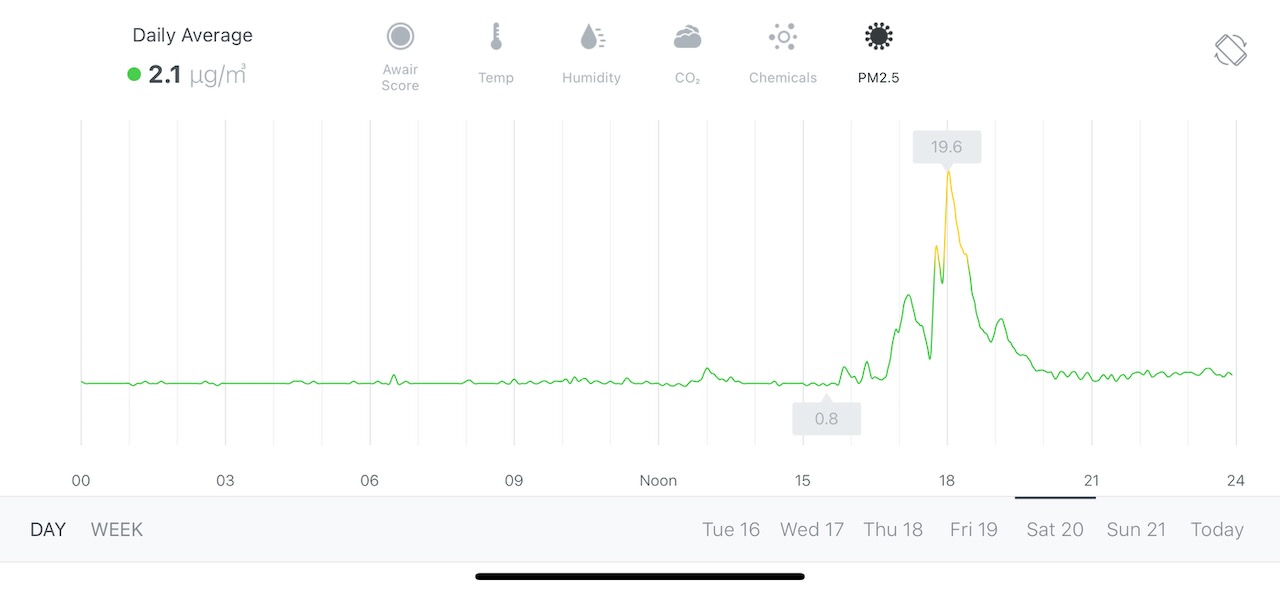
When I made the fire in my house, I watched the PM2.5 readings on my Awair Element IAQ monitor. The time period when the fire was going is easy to spot in the graph above. The four identifiable spikes in the elevated region are probably times when I opened the doors to add wood or move things around.
Overall, though, the PM2.5 stayed fairly low and came down quickly when it spiked. With a woodstove insert, I think it’ll stay in the green almost the whole time.
The nitty gritty
Fireplace building science doesn’t get discussed much. I think part of that is due to a lot of building science folks not having or using fireplaces, especially the kind that sucks a lot of air and heat out of the house. (Ethanol fireplaces are somewhat popular with the passive house crowd, but that’s a topic for another day.) But with efficient combustion and a source of combustion air, they’re not a big thermal or IAQ liability, especially if the chimney goes up through the house instead of the outside.
Do you use a fireplace or woodstove? What’s your experience with burning wood in airtight homes? Leave a comment below.
Allison A. Bailes III, PhD is a speaker, writer, building science consultant, and the founder of Energy Vanguard in Decatur, Georgia. He has a doctorate in physics and is the author of a bestselling book on building science. He also writes the Energy Vanguard Blog. For more updates, you can subscribe to Energy Vanguard’s weekly newsletter and follow him on LinkedIn.
Related Articles
Heat Pumps, Auxiliary Heat, and Resilience
Is an Unvented Gas Fireplace More Efficient Than a Condensing Furnace?
The 3 Main Sources of Home Heating
Comments are welcome and moderated. Your comment will appear below after approval.
This Post Has 31 Comments
Comments are closed.

I my Pretty Good House, I installed two sealed gas log units that use outside air for combustion. With them, I can more than heat the house should I need to, in fact, one would probably meet the BTU requirement. Most of the time it is for ambiance and a little radiant heat if desired, but it has to be quite cold or it will run you out of the house. 🙂
It is a pity that manufacturers do not create gas log fireplaces that can easily coexist with tight, well insulated homes.
Norman: The woodstove in the house I built was similar. I think the outdoor temperature had to be in the 40s Fahrenheit, maybe even the low 40s, or it would overheat the house.
We used not to have a choice: we had to burn stuff or freeze, even though it was shortening our lives; there is no safe level of particulates. We do have a choice now and a lot more knowledge about the dangers, and I don’t think we should be burning stuff anymore, period.
Lloyd: I hadn’t heard about the “no safe level of particulates” thing, so I’ll have to look into that.
Dr. Bailes,
Thank you for the very nice article about fireplaces. I would like to mention an experiment that is alarming on first thought but clearly demonstrates radiant heating.
The effect of radiant heating is overlooked by most people, even those educated in science! When I was investigating the history of electricity I discovered an early experiment by Pictet* in 1790 that was, at first thought, amazing. Back then, to explain the phenomenon, they even postulated the existence cold ‘rays’ and called them “frigorific rays”.
With our knowledge today, we know that this heating or cooling effect is due to electromagnetic radiation (i.e. infrared) and Pictet’s experiment demonstrates this clearly. Perhaps you can use this in a future article.
* See Wikipedia for Pictet. Also google William Herschel who discovered infrared radiation and its effect on heating objects in 1800.
Alan: I hadn’t heard of Pictet or frigorific rays. I’ve got some reading to do now. Thanks!
1903 stick Victorian, foam insulation and as airtight as I could make it in a historic district. Relined the chimney, good damper, at center of house and have gas logs. Used only for ambience and auxillary heat for heat pumps because gas far cheaper than resistamce heat elements. Next heat pumps slightly larger and no resistance elements.
When logs lit, Awair clearly shows rise in p2.5 and VOCs. Clearly less than wood logs, and quickly go down. I suspect the good air filters help.
I wonder if a catalytic insert would work to increase efficiency and decrease pollution inside and out.
I installed a Fisher insert in my masonry fireplace (outside) in the early eighties and actually used in a lot for a few years. Since the house was built in the early eighties as well, it is about as airtight as a screen door. I haven’t used the insert now for years for the same reason many do not. Firewood and ashes are a pain.
The comments to a recent article in the Washington Post said the outdoor pollutants were pretty bad, even from the best of the EPA approved woodstoves. Have you looked into this?
RobertJ: Yes, they do add to the outdoor pollution load. No, I haven’t looked into it. In my case, I’m just looking for an occasional source of supplemental or emergency heat.
I did a room by room Manual J for a new house using the coldest temperature of -29F. An electric fireplace works just fine and can modulate between 0 to 5000 BTUh of heat.
Our Club House has a non-vented gas fireplace which is unacceptable to use. Is there any gas insert that would be easy to adapt?
Dr. Raborn: I’ve never looked into that. Seems to me the best thing to do would be to get it vented to the outdoors or remove it.
Good article, just a slight correction:
Unvented fireplaces are not “lung vented”. They are room vented and lung filtered. LOL.
Touché!
I’m in Wisconsin and bought a 1960s house with a standard fireplace — you know, a “big hole in the house.” I immediately installed a wood burning high-efficiency insert and chimney liner. Fortunately the fireplace was built in an addition and whenever that was done they had the sense to include direct outdoor combustion air, which still serves my insert. Rather than a masonry chimney, the fireplace was built with a metal outdoor chimney that goes up to above the roof, all the while keeping a foot away from the house. Essentially a large direct vent. I’d love the be able to capture that heat from the chimney inside the house’s envelope, but that’s not what I’ve got. The insert heats the addition nicely. I believe we could stay livable in the addition if we lost power even in an “arctic blast.”
I have an EPA-certified woodstove that runs most of the winter. But my house is not airtight. It seems to me that wood burning in places that have significant trees is a sensible part of sustainable living. What else should be done with dead trees and storm debris?
Dead trees rot. We live in (on) a closed system. All biomatter is recycled.
Yes, but the point is that in the process of rotting, trees release as much CO2 as if they were burned. So why not burn them?
i am a design build company since 1978. i always allow for a efficient woodstove in my designs with outside air makeup since 1978.It is the ultimate backup for rural folk. i also design and build (some) Rumford fireplaces, having taken a course with the late Donald Carpentier of Eastfield village, Connecticut, again makeup air and in the last ten years i have incorporated large gasketed steel doors for these units and the performance is amazing. most of my homes are rural in location to a degree and usually have access to wood. i live off grid with batteries and i have a beautiful cookstove by the Amish near Kitchener, Ontario that cooks my food, heats my modest home and heats my hot water. our wood is supplied by only blow down old trees on our 32 acre property. never cut a live tree in 40 plus years. i am blessed. wood is wonderful heat and a the occasional fire on a Sunday evening with a glass of wine or warmed port is truly a reward. Done correctly with simplicity and knowledge wood burning units are fantastic. i build houses as tight as .47 ACH and do not experience any issues with wood heat done correctly.
Great article Allison!
I’m currently working on a new home in Northern Minnesota with a sealed fireplace that uses outside air for combustion. I recently performed its mid-build blower door test, 140 CFM50, .39 ACH50, .021CFM/Ft² surface area. The home will have a ducted dryer and ducted range hood (350CFM rating). We have an ERV that will be pulling air from the bathrooms instead of dedicated bath fans. We are also installing a heated make up air system that will be activated by both the range hood and dryer (Electro Industries). I’m planning on testing the home in several different configurations to see the effects of burning a fire in a really tight home once the build is complete. I’ll be writing an article for GBA on the findings. Should be a fun one to test!
How does a blower on the fireplace affect the overall net heat gain/loss?
It will help pull more heat into the room, rather than allowing it to go up the chimney. But for an open fireplace, you will still not get much heat out of it compared to the amount of wood you are burning. To word it differently, if you burned the same amount of wood in an insert or a free standing woodstove, you would get a lot more heat. If you assume an open fireplace is about 5-10% efficient, an insert is about 60-75% efficient, and a free standing wood stove might be 70-80% efficient. Rough estimates and obviously depends on the unit or how your fireplace was constructed. A blower will bring more heat into the room in any of those scenarios. Many people don’t use one on a free standing woodstove because they already get more than enough heat without it. Most inserts will still need a blower to heat a large area.
If you are going to invest in a woodstove or an insert, you would be wise to start acquiring firewood now. Modern, high-efficiency, low pollution wood burners need DRY firewood to operate properly. This is absolutely critical to having a smoke free burn (other than a freshly started fire or wood added to the fire). A good rule of thumb is to cut and split your wood (or buy it) and store it under cover for a minimum of 2 years for hardwood and 1 year for pine. I typically store mine for at least 3 years. You can also buy an inexpensive moisture meter to test it and ensure it is below 20% moisture content. To test properly, you need to make a fresh split and immediately test the newly exposed surface. You should bring it up to about 70 deg F for most meters by bringing a stick of wood indoors for a few hours before you take it back out to split it.
I had a Lopi insert installed in our house (built 1987). It has an exterior chimney, so I used an insulated chimney liner. In hindsight, I wish I had used high heat insulation board to insulate the masonry fireplace itself before installing the unit.
Great article! Its so nice to see an expert building scientist like you addressing wood burners, and actually using one.
Brian: Yes, firewood needs to be dry, and I’ve got that covered. I’ve got a small woodshed I built in 2019 that still has wood in it from 2019 and 2020. I’ve got another covered pile that’s been drying for a year and a half now.
If you have an outside ash dump in an old fireplace, just open the ash dump doors outside and on the firebox floor and use sealed glass doors – that will provide all the combustion air you need and control PM – just be sure to close the doors after the fire goes out.
I bump up the outside air and reduce the exhaust air on the ERV when the wood insert gets used because you made me OCD about make up air.
Of additional note:
Fresh plant agrofuel is a horrible source of energy as it’s BTU density is low.
You address indoor micro particulate pollution but not outdoor. Wood fires release micro particulates that are harmful. See any wildfire air quality advisories.
There is no surplus fuel. We live in a closed system. The sooner humanity grasps the full, long-term consequences of combustion in a closed system, the better off for all.
The type of wood-burner I found to work exceptionally well in the tight home we built in the Upper Peninsula of MI was a masonry heater (Tulikivi brand). The unit was made of soapstone and assembled on-site. This “small”, demonstration model still weighed about 1800 lbs. The idea was to burn a fire hot and fast, then after combustion close the dampers and allow the heat to radiate into the room. The heat would last almost 24 hrs. Though I plumbed in outside combustion air, I found I didn’t need it. As Allison did, I’d open a window only for the minute or two needed to start the fire, then close it. All continued to burn very hot and fast. As I recall, rated efficiency was in the 70% +/- range. Great for the coldest U.P. days and when the power went out – especially with the cast iron cooktop.
A house I worked on n 2007 went for the works, masonry heater, PV solar thermal and well insulated. When I spoke to him a year later he said if he had to do it over again, he would put the money for the heater into more insulation.
Dr. Bailes- Sorry your heat pump didn’t keep up. I am guessing it’s because your design temp and hence a likely non cold climate heat pump was specc’d. in Colorado, the Cold Climate is a must. our non cold climate dual fuel where we removed the gas line obviously lagged at -10. but we felt alive and baked a lot.